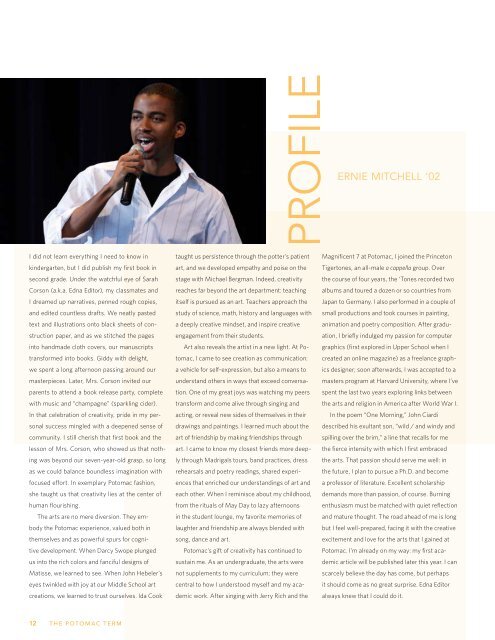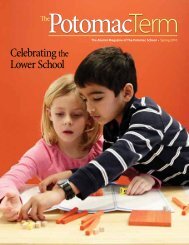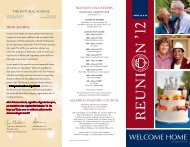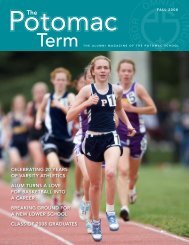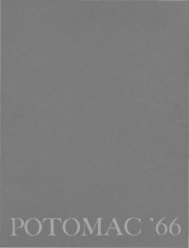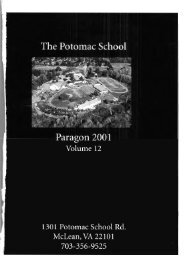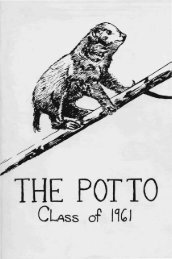Spring 2009 Potomac Term - Potomac School
Spring 2009 Potomac Term - Potomac School
Spring 2009 Potomac Term - Potomac School
Create successful ePaper yourself
Turn your PDF publications into a flip-book with our unique Google optimized e-Paper software.
I did not learn everything I need to know in<br />
kindergarten, but I did publish my first book in<br />
second grade. Under the watchful eye of Sarah<br />
Corson (a.k.a. Edna Editor), my classmates and<br />
I dreamed up narratives, penned rough copies,<br />
and edited countless drafts. We neatly pasted<br />
text and illustrations onto black sheets of construction<br />
paper, and as we stitched the pages<br />
into handmade cloth covers, our manuscripts<br />
transformed into books. Giddy with delight,<br />
we spent a long afternoon passing around our<br />
masterpieces. Later, Mrs. Corson invited our<br />
parents to attend a book release party, complete<br />
with music and “champagne” (sparkling cider).<br />
In that celebration of creativity, pride in my personal<br />
success mingled with a deepened sense of<br />
community. I still cherish that first book and the<br />
lesson of Mrs. Corson, who showed us that nothing<br />
was beyond our seven-year-old grasp, so long<br />
as we could balance boundless imagination with<br />
focused effort. In exemplary <strong>Potomac</strong> fashion,<br />
she taught us that creativity lies at the center of<br />
human flourishing.<br />
The arts are no mere diversion. They embody<br />
the <strong>Potomac</strong> experience, valued both in<br />
themselves and as powerful spurs for cognitive<br />
development. When Darcy Swope plunged<br />
us into the rich colors and fanciful designs of<br />
Matisse, we learned to see. When John Hebeler’s<br />
eyes twinkled with joy at our Middle <strong>School</strong> art<br />
creations, we learned to trust ourselves. Ida Cook<br />
PROFILE<br />
taught us persistence through the potter’s patient<br />
art, and we developed empathy and poise on the<br />
stage with Michael Bergman. Indeed, creativity<br />
reaches far beyond the art department: teaching<br />
itself is pursued as an art. Teachers approach the<br />
study of science, math, history and languages with<br />
a deeply creative mindset, and inspire creative<br />
engagement from their students.<br />
Art also reveals the artist in a new light. At <strong>Potomac</strong>,<br />
I came to see creation as communication:<br />
a vehicle for self-expression, but also a means to<br />
understand others in ways that exceed conversation.<br />
One of my great joys was watching my peers<br />
transform and come alive through singing and<br />
acting, or reveal new sides of themselves in their<br />
drawings and paintings. I learned much about the<br />
art of friendship by making friendships through<br />
art. I came to know my closest friends more deeply<br />
through Madrigals tours, band practices, dress<br />
rehearsals and poetry readings, shared experiences<br />
that enriched our understandings of art and<br />
each other. When I reminisce about my childhood,<br />
from the rituals of May Day to lazy afternoons<br />
in the student lounge, my favorite memories of<br />
laughter and friendship are always blended with<br />
song, dance and art.<br />
<strong>Potomac</strong>’s gift of creativity has continued to<br />
sustain me. As an undergraduate, the arts were<br />
not supplements to my curriculum; they were<br />
central to how I understood myself and my academic<br />
work. After singing with Jerry Rich and the<br />
Ernie Mitchell ‘02<br />
Magnificent 7 at <strong>Potomac</strong>, I joined the Princeton<br />
Tigertones, an all-male a cappella group. Over<br />
the course of four years, the ‘Tones recorded two<br />
albums and toured a dozen or so countries from<br />
Japan to Germany. I also performed in a couple of<br />
small productions and took courses in painting,<br />
animation and poetry composition. After graduation,<br />
I briefly indulged my passion for computer<br />
graphics (first explored in Upper <strong>School</strong> when I<br />
created an online magazine) as a freelance graphics<br />
designer; soon afterwards, I was accepted to a<br />
masters program at Harvard University, where I’ve<br />
spent the last two years exploring links between<br />
the arts and religion in America after World War I.<br />
In the poem “One Morning,” John Ciardi<br />
described his exultant son, “wild / and windy and<br />
spilling over the brim,” a line that recalls for me<br />
the fierce intensity with which I first embraced<br />
the arts. That passion should serve me well: in<br />
the future, I plan to pursue a Ph.D. and become<br />
a professor of literature. Excellent scholarship<br />
demands more than passion, of course. Burning<br />
enthusiasm must be matched with quiet reflection<br />
and mature thought. The road ahead of me is long<br />
but I feel well-prepared, facing it with the creative<br />
excitement and love for the arts that I gained at<br />
<strong>Potomac</strong>. I’m already on my way: my first academic<br />
article will be published later this year. I can<br />
scarcely believe the day has come, but perhaps<br />
it should come as no great surprise. Edna Editor<br />
always knew that I could do it.<br />
12 The <strong>Potomac</strong> <strong>Term</strong>


